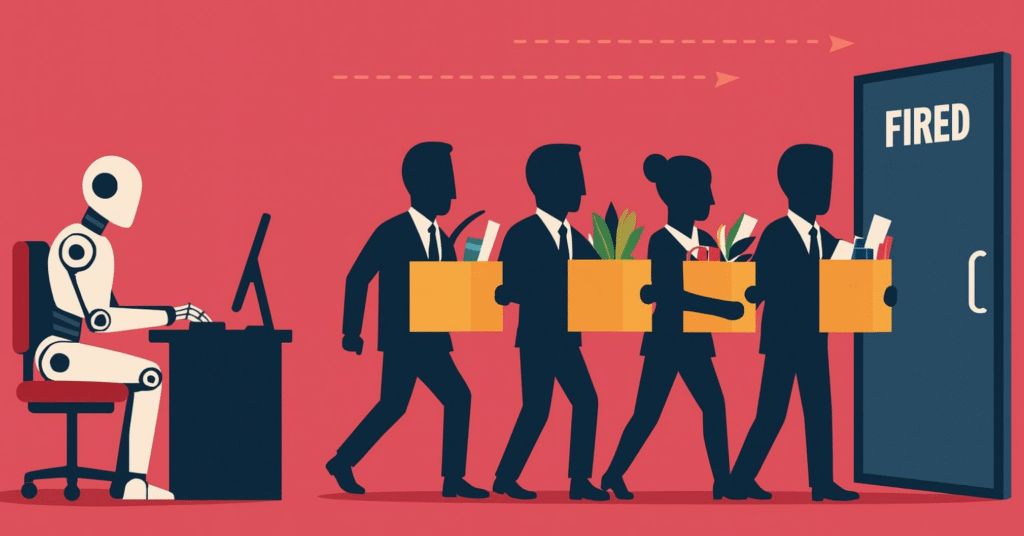In recent months, headlines have been flooded with news of mass layoffs across industries — from tech giants like Google, Amazon, and Meta to startups, manufacturing firms, and even financial institutions. The year 2025 has seen a surge in job cuts that has raised alarm among professionals and job seekers alike.
But what’s really driving this wave of layoffs? Is it automation? Is it the economy? Or is there something deeper going on?
Let’s take a closer look at the real reasons behind the layoffs, how they’re affecting the workforce, and what you can do to prepare.
Table of Contents
📉 What’s Happening: The Layoff Trend in 2025
Across the globe — and especially in India, the US, and Europe — companies are announcing layoffs almost weekly. From a 10% staff cut at multinational corporations to complete shutdowns of mid-sized startups, the job market is undergoing a major reset.
According to Bloomberg and LinkedIn data:
- Over 4 million people have been laid off globally in just the first half of 2025.
- Technology and retail sectors have been hit the hardest.
- Indian IT firms like Infosys, Wipro, and even newer unicorns have trimmed headcount due to margin pressure and global demand slowdowns.
But why?

💣 Major Reasons Behind the Layoffs
1. Overhiring During the Pandemic Boom
During 2020–2022, companies aggressively hired to meet the sudden surge in demand for digital tools, e-commerce, and remote services. But as the post-pandemic economy stabilized, that growth didn’t continue at the same pace.
Now, many businesses realize they’ve built teams that are larger than necessary, leading to downsizing.
2. Economic Slowdown and Recession Fears
Global inflation, fluctuating interest rates, supply chain disruptions, and geopolitical tensions (like the Ukraine crisis and Middle East conflicts) have slowed business growth. Companies are cutting costs to survive — and payroll is often the first place they look.
Even profitable firms are laying off workers to appease investors and maintain stock value.
3. AI and Automation Replacing Human Roles
The rapid adoption of AI tools and automation in customer service, content creation, data analysis, and logistics has made several job roles redundant.
Tasks once requiring human effort are now being done faster, cheaper, and more efficiently by machines — leading to tech-based job losses in both blue-collar and white-collar roles.
4. Shift to Contractual and Freelance Models
To remain flexible, many firms now prefer hiring freelancers, gig workers, or part-timers instead of maintaining full-time staff. This “variable workforce” model saves them money on salaries, insurance, and long-term liabilities.
Full-time jobs are being replaced with project-based contracts.
5. Startup Burnout and Funding Drought
Many startups raised massive funds between 2020–2022. But with venture capital drying up and pressure to show profits, startups are scaling back fast — shutting down non-performing departments and laying off employees who don’t fit into revised business goals.
🧠 How Layoffs Affect the Workforce
Layoffs don’t just affect those who lose jobs — they create anxiety, uncertainty, and competition across the employment market. People still in jobs begin to fear instability, often leading to lower productivity, morale issues, and a sense of constant stress.
In India especially, where job security is deeply valued, layoffs have a deeper psychological and social impact.
AI vs Jobs: How Artificial Intelligence Is Changing the Future of Work

🔍 Which Sectors Are Most Affected?
❌ Impacted Sectors:
- Tech & Software Development
- Retail & E-commerce
- Real Estate & Construction
- Banking & FinTech Startups
- Customer Support/BPO
✅ Safer or Growing Sectors:
- Healthcare and Pharmaceuticals
- Cybersecurity
- Green Energy & Climate Tech
- AI and Machine Learning Specialists
- Digital Education and Upskilling Platforms
🛡️ How Can Employees Protect Themselves?
While layoffs aren’t always predictable, here are ways to prepare:
1. Upskill Continuously
Learn in-demand skills like AI tools, cybersecurity, project management, or data analytics. Platforms like Coursera, LinkedIn Learning, and NASSCOM FutureSkills are great resources.
2. Build a Personal Brand
Don’t just be an employee. Create visibility by contributing on LinkedIn, writing blogs, speaking at events, or showcasing your portfolio.
3. Network Regularly
Stay connected with peers, mentors, and industry professionals. Referrals are one of the top hiring methods, especially during slow job markets.
4. Maintain a Side Hustle or Passive Income
Whether it’s freelancing, investing, or building a small online business — having multiple income streams gives you financial resilience.
Top 10 Booming Business Models in India (2025): How Entrepreneurs Are Winning Big

🔮 What’s Next for the Global Workforce?
We are entering an age where adaptability and learning are more valuable than any single degree or title. The layoffs of 2025 are not just about financial challenges; they are about companies adjusting to a new economic and technological reality.
Jobs are not disappearing — they are transforming. Roles that didn’t exist 5 years ago, like AI ethics officers, data storytellers, or metaverse designers, are now in demand.
To stay ahead, workers must be curious, tech-aware, and flexible.
🎯 Final Words: Layoffs Are a Wake-Up Call — Not the End
While no one wants to face job loss, this wave of layoffs serves as a reminder that career security no longer comes from staying in the same role or company for years. It comes from staying relevant, resilient, and ready to adapt.
If you’re worried about the future — don’t panic. Instead, prepare.
Because in the new economy, the most powerful skill is the ability to reinvent yourself.











One thought on “💼 The Layoff Wave of 2025: Why So Many Companies Are Cutting Jobs and What It Really Means”